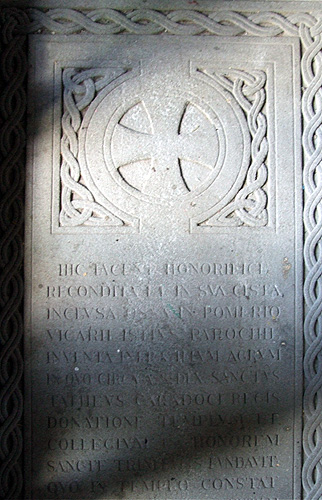 |
 |
|||
|
|
Tathyw is usually said to have been
an Irish prince, the son of one King Tuathal, an Irish form of Tudwal.
His pet name was, apparently, 'Meuthi'. According to Tathyw's 11th century 'Life',
he was encouraged to join the Church by his pious parents and was directed by an
angel in a dream to spread the Christian word in Wales. So the young prince sailed across
the Irish Sea with seven companions in a small boat without sail or oars. They
eventually landed in Gwent and were honourably received by a local nobleman.
Tathyw
soon gained quite a reputation in the neighbourhood and his ministrations came
to the attention of King Caradog of
Gwent. The monarch sent Tathyw an invitation to visit the Royal Court at the old Roman
town of Caerwent, but
the saint declined. Undeterred, King Caradog, accompanied by his
twenty-four knights, went to see him in person. So impressed was the
monarch, by Tathyw's words of wisdom, that he gave him a large amount of
land upon which to found a monastery dedicated to the Holy Trinity. The
"piece of land nigh unto the city, extending from the high road even
to the river" was presumably Christchurch (Eglwys y Drindod), eight miles west of Caerwent.
There, he founded a Collegiate Church for twelve canons. Soon afterwards,
a nobleman, wishing to devote one of his ten sons to a religious life,
persuaded St. Tathyw to take him on as a novice, in return for a fine cow
which could supply all the canons with milk. One night, some trouble makers turned forty-seven of King Caradog's horses out into Tathyw's meadow, where they spoiled his crop of hay. The horses were subsequently struck dead but, when the King visited Tathyw in person to apologise, the saint restored them all to life. Caradog then decided that the walls of Caerwent were a more suitable setting for Tathyw to live. He handed the whole town over to him and erected a new palace for the Royal court at Portskewett. The saint seems to have built himself a second abbey church within the old Roman ruins south of the great basilica. The present parish church at Caerwent stands there today. It is dedicated to St. Stephen, a corrupt form of Tathan/Tathyw, favoured because the two saints have the same feast day. St. Tathyw's famous cow was the cause of a major conflict with King Gwynllyw of nearby Gwynllwg. Being a warrior king well known for his lawlessness, Gwynllyw went on a wild celebratory raid on Gwent after the birth of his first son. Among other livestock, his warband stole the cow from Tathyw's monastery, and took it make to Gwynllwg. Tathyw followed them and, confronting the monarch in his Royal hall, demanded back his property. Influenced by his Christian queen, Gwynllyw agreed to return the beast on the condition that the saint baptise his new-born son, "Cadfael". Later, the boy was sent to be educated at Tathyw's monastery in Caerwent, where he was commonly called Cadog. He was to become one of the greatest of Welsh saints, founding the great monastic school at Llancarfan. Tathyw probably visited him there, founding a small church at nearby Llanfeuthin. It was Cadoc's sister, St. Maches, whose body Tathyw buried in the centre of his church, after her whereabouts was revealed to him by the repentant robbers who had murdered her. After his death, on 26th December sometime in the early 6th century, Tathyw is recorded to have been buried under the floor of his church at Caerwent. Some of his relics later found their way to Tewkesbury Abbey in Gloucestershire. These facts clearly shows that the post-Roman stone-lined burial, discovered outside the East Gate in 1910, was not St. Tathyw: despite the excavators having the dead person therein reburied in the church under a beautiful inscribed slab to his memory. This man could, however, have been one of his congregation for he was buried in a large Christian cemetery dating from the 4th to the 9th century which, along with a second cemetery around the church, was almost certainly associated with Tathyw's monastery. Tathyw should not be confused with the female St. Tathan of St. Athans, near Llanilltud Fawr (Llantwit Major). Records of Tathyw date back to the 11th century. He is generally considered historic.
|
|||
| © Nash Ford Publishing 2003. All Rights Reserved. | ||||





 St. Tathyw, Abbot of Caerwent
St. Tathyw, Abbot of Caerwent